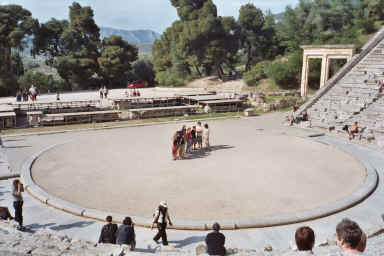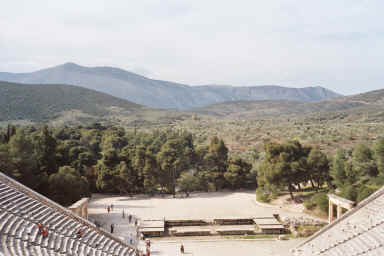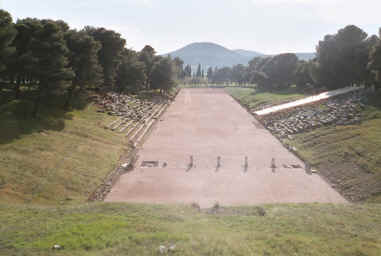| Unquestionably the most famous "ruin" at Epidauros (confusingly pronounced "Epidavros" in modern Greek) is the theater. It is one of the largest and most well-preserved of all Greek theaters and has phenomenal acoustics. As we were entering the theater, a tourist from a group of young people (who were either French or French Canadian) was playing the flute. After she finished, another young woman from the same group sang an aria a capella. (My mother recognized the aria and knows its name, but I can't remember!)
While Vernon, Aurora, and I took seats in the theater to watch the continuing parade of tourists and tour guides test the acoustics, Julian and Michael climbed to the top and took the photos shown below along the way |
 Approaching the ancient theater |
 View of the stage |
 Looking down from the top |
 View from the top |
After we finished admiring the theater, we walked across the site, past the museum, to the rest of the ruins, which aren't so well-preserved as the theater. There is an active project to reconstruct many of the monuments, which I must admit I tend to frown on (more later!).
The first of these ruins are the remains of the hostel where people visiting the sanctuary stayed before and sometimes after completing their treatments (or while waiting for a family member to receive treatment). The hostel consisted of four courtyards with "hotel rooms" facing onto them. The door lintels of many of the rooms as well as the foundations are very clear. The rooms were small by modern standards, but it's still very recognizably a hotel, which I found rather striking.
|
 Ruins of the hostel |
 Hostel ruins (courtyards clearly visible) |
| We spent quite a bit of time in the hostel ruins because Julian met two little girls about his age who were also from the States, and they were having a good time playing together. We finally pried him away, though, so we could see the rest of the site.
One of the nicest and most striking thing about Epidauros is how forested it is. The hostel site is separated from the main sanctuary by a hill covered with some sort of pine tree (a bit like an Italian stone pine, I think) and other, leafy trees. And, while you can't tell from the photos, the grass was absolutely peppered with wildflowers, which probably explains why we heard the buzzing of what seemed like millions of bees every time we walked through the trees.
|
 First view of the sanctuary |
The photo at right gives a good overview of the site. In the foreground are the foundations of a gymnasium. Towards the center, in front of the scaffolded building, are the remains of another building that encloses a Roman odeon (indoor theater). The scaffolded building is the Apollo temple, which is in the process of being reconstructed. It also illustrates one of the reasons I dislike reconstruction efforts: I really hate to see ancient buildings surrounded by modern scaffolding. It just looks ugly, darn it!
The ritual to effect healing included eating a communal meal, a ritual bath in the local spring, and sleeping in a barracksknown as the Abaton. The postulant's dreams would then provide clues to effecting a cure. |
Ritual healing isn't the only thing the medical practitioners were up to at Epidauros, though. The discovery of a number of medical instruments during excavation indicates that there were practical, as well as religious, healing techniques in use there.
Below the main sanctuary (to the left of the photo above) is the stadium. It's not the best-preserved stadium we saw, by any means (I think that honor goes to Delphi, paradoxically, since you'd have thought it would be at Olympia), but it was the first one we saw during our trip. The start-finish line is clearly visible and the seating blocks on one side have been restored. The siting of this stadium is also quite striking, with the trees on either side and mountain centered behind it.
|  The stadium |
